One fitting issue some women have is how to fit a sweater for a generous bust without it becoming a gunny sack. You may not know that the “Ms. Average” that the the fashion industry designs for is a B cup. So if you are larger than a B cup, OR if the difference between your upper chest circumference and your bust circumference is more than an inch or so, AND you are making a fitted style sweater, you will probably want to include some bust shaping.
I have basically no background in the generous bust department. But some of my students do. Here is one successful example of how we included short-row bust darts in a top-down raglan sweater.
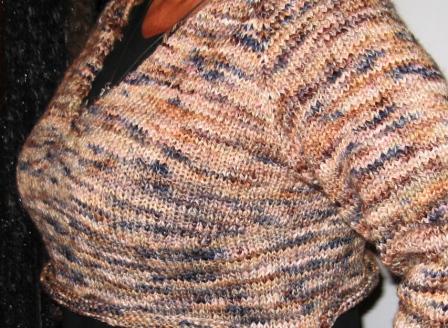
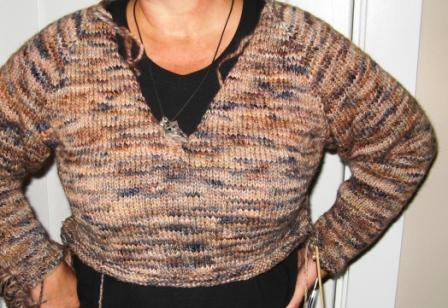
How’s that for a work of art? How’s that for no extra big wad of fabric under the arm, huh??
Here’s the short-row bust dart section that saves the day!
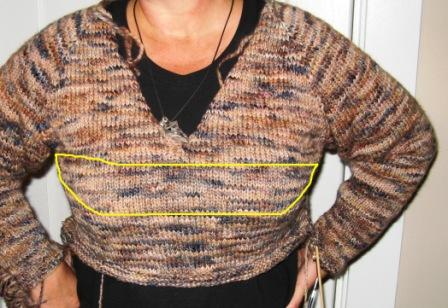
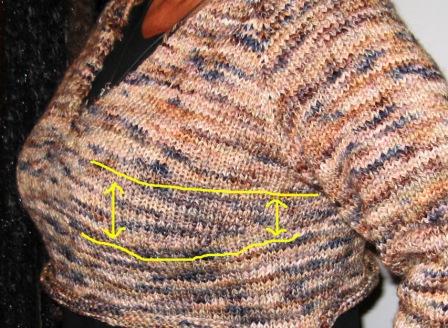
Fitting a horizontal short-row bust dart
First off, you need to decide just how big to make the bust darts, and where to place them. I started with an article out of Knitty, which suggests the following:
The vertical length of this section depends on your cup size. Estimate about 0.75 to 1 inch for a C cup, and add 0.75 to 1 inch for each full increment (to D, E, etc.).
The short rows start slightly below your bust point, so that when the short row section is complete, it is level with your bust point… this is probably a couple of inches below the beginning of the [underarm] shaping, and may vary according to cup size.
The first pair of short rows should end about 1 inch shy of the side seams. The last pair should end about 1 inch outside the bust point.
I agree with 2 out of 3. My opinion is this:
Thumbs up on where the short rows should be placed (1″ – 3″ inches below the underarm shaping, 1″ for a smaller bust – 3″ for a larger bust). The short row bust dart should be no higher than the bust point, so the line made by the short row shaping “points” to the fullest part of the bust.
Thumbs up on how long the bust dart should be: starting an inch from the side seam, and ending an inch from the bust point. This dimension is pretty easy to measure.
I disagree with the cup size thing, though… I don’t believe a one-size-fits-all rule of thumb works here. There’s one more very important factor to think about and that is, the amount of ease in the garment you are knitting.
The less fitted your sweater is, the less of a “pocket” you’re gonna need for the girls, right?
Or, think about it this way: if the sweater is baggy enough, it doesn’t need any kind of bust shaping! Per Maggie Righetti, knitted fabric will stretch to “accommodate lemon-sized, orange-sized, and sometimes grapefruit-sized breasts.” I have my doubts about the grapefruits, although bear in mind she was writing this in the late 80’s, when sweaters were less fitted than they are today, and possibly produce was a little smaller.
So, we did things a little differently, after one of the other knitters in the group had a sort of epiphany: she figured out how to measure the size of the short-row section. 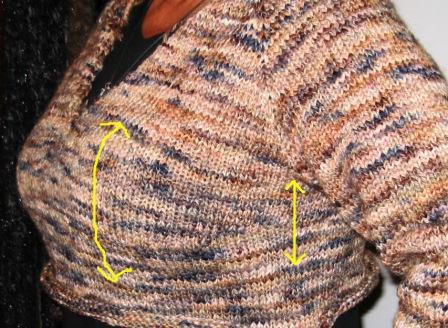
Basically, the length of the short-row section needs to be the difference between these two measurements:
- the length the fabric needs to be to go over the fullest part of the bust, and
- the length the fabric needs to be to go over the part with no bust.
Almost obvious, once you look at this picture: the distance over the bust is of course longer than the distance down the side, and it’s this difference that needs to be accommodated with the short rows.
But the great thing about it is, you can measure this distance instead of guesstimating! And that’s the best way to figure out how long the bust dart section should be.
And finally, notice it’s the difference in the lengths of the fabric needed – which means, not necessarily the actual body measurements — it means the body measurements with ease included. If this sweater were looser, the difference in fabric needed to go over the bust would be less.
For this particular sweater, we chose to make the short row section a full inch longer than the Knitty cup-size estimation indicated, as it is rather fitted. This “pocket” is a little on the snug side, so we could probably have gone with even a half-inch deeper dart, without it being too big a pocket. So this example bears out my thoughts that the cup-size estimate isn’t really useful.
Note: There are two kinds of bust darts: vertical and horizontal. Vertical ones are easier to calculate and knit. However, vertical bust darts DO change the overall stitch count and may require that you decrease out those extra stitches once you get past the bust. Horizontal short row bust darts DO NOT affect the stitch count, and do not have to be compensated for later.
Designing a horizontal short-row bust dart
A short-row bust dart starts 1-3” below the underarm, at or slightly below the bust point, so when the section is complete, the dart points to the fullest part of the bust. When working top-down, the bust dart starts 1-3″ after the underarm shaping is complete, when you have the full width of the sweater body on the needles.
As far as the actual shape goes, it doesn’t matter a whole lot whether you start with the shortest row and make each successive row longer, working up the previous row’s wrap each time; or start with the longest row and make each successive row shorter, and work up all the wraps on the final two rows. These directions are for the latter method.
Step 1: Calculate the depth of the dart.
Put the end of a tape measure on the shoulder seam of the wearer. Measure the distance from the shoulder seam to the bottom of garment (or any convenient horizontal landmark), over the fullest part of the bust. Try to keep the tape measure as snug against the body as you intend the sweater to be. From the experience with the sweater in the pictures, I believe it is easy to measure the top part of the bust, but it is also important to have the tape measure as close under the bust as the the sweater is going to be. In other words, don’t just let the tape measure hang off the point of the bust, unless your sweater is going to hang that loosely also. Follow the whole curve of the bust, including the underneath part.
Then keep the end of the tape measure on the shoulder, and rotate it to take the same measurement down the side of the body, near the underarm, as in the picture above.
The difference between these two measurements is how deep the dart will be.
- Convert this measurement to rows. It has to be an even number of rows, so round up or down accordingly.
- Subtract out the final 2 rows of the dart to get the number of rows you have to work with.
- Divide that by 2 for each pair of short rows to get the number of short row turns for each dart.
Example: a 2″ section, at a gauge of 6 rows per inch, means 12 rows. This gives 10 rows to work with, or 5 turns for each dart.
While you’re here and you’ve got the tape out, stick a knitting needle or a chopstick or something in your armpit, turn to the side in front of a mirror, and measure vertically from your shoulder to the stick, and from your shoulder to your bust point. The difference between these two measurements gives you a guesstimate on where to start the dart, although it does NOT include underarm ease. The actual underarm of the garment is going to be at least an inch lower than a chopstick stuck in your armpit, so subtract at least an inch, or more for larger sizes, and start your dart that far below the underarm shaping.
Example: the vertical distance between the chopstick and your bust point is 3″. Subtract out at least an inch for underarm ease, so start your dart 2″ below the garment underarm.
If you are knitting top-down, of course, you can try the sweater on once you’ve got the yoke completed, and you are a few rounds into the body, and you will be able to actually measure the vertical distance from the garment underarm to your bust point. But if you are working bottom-up, this is probably the best you can do for an estimate.
Step 2: Calculate the width of the dart.
The first pair of short rows should end about 1” shy of the side seams. The last pair should end about 1” outside the bust point. All the short rows in between are as evenly spaced as possible.

- Measure the distance between the points of the breasts.
- Subtract this from the width of the sweater front.
- Subtract another 4” to allow for the bust darts to start and end 1” from the side seams and bust points.
- Divide by 2 to get the length of each dart and convert this to stitches.
Example: a 40″ sweater circumference means 20″ across the front. Suppose the distance between the girls is 8″.
20 – 8 – 4 = 8″ left for the darts, or 4″ for each dart.
A 4″ dart, at a gauge of 4.5 stitches per inch, means 18 stitches per dart.
Step 3: Calculate the number of sts to leave unworked for each short row.
Divide the number of stitches from step 2 by the number of turns from step 1. This is how many sts shorter each short row is going to be.
Example: 18 stitches per dart / 5 turns per dart = 3.6 stitches per turn.
Obviously we can’t knit 3.6 stitches. And this number is right between 3 and 4, so we can’t conveniently round up or down. What I’d do with this number is, I’d alternate. On the first two short rows (one on each side), I’d make them 4 stitches shorter. The next two would be 3 stitches shorter. My 5 pairs of short rows would be shorter by 4, 3, 4, 3, and 4 stitches, for a total of 18 stitches per dart.
Knitting a horizontal short-row bust dart
Note: the short row section is worked flat, even if the sweater is in the round.
Work a RS row across the front to within 1” of the side seam. Wrap & turn. (Or use any other short-row method you prefer – see this post for a summary of several methods.)
Work a WS row across the front to within 1” of the side seam. Wrap & turn.
Continue to work shorter and shorter rows across the front of the sweater, each one shorter than the previous one by the number of sts calculated in step 3, until you have worked all the necessary short rows. You should have enough sts in the last two short rows to go across the bust points plus 1” to either side.
Turn and work one final RS row across the middle and one side, working up the wraps on that side. If working in the round, here you will continue around the back of the sweater, and work up the other half of the wraps when you get to the front again. If working flat, work a final WS row across the entire front, working up the wraps on the other side.
And your short row bust dart is done! You can now happily resume working the rest of the sweater, knowing that this one is going to fit better. 🙂

3 comments for “How to Knit Better Short-Row Bust Darts”